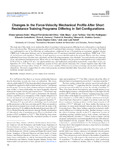Mostrar o rexistro simple do ítem
Changes in the Force-Velocity Mechanical Profile After Short Resistance Training Programs Differing in Set Configurations
| dc.contributor.author | Carballeira, Eduardo | |
| dc.contributor.author | Iglesias-Soler, Eliseo | |
| dc.contributor.author | Fernández-del-Olmo, Miguel | |
| dc.contributor.author | Mayo, Xián | |
| dc.contributor.author | Fariñas Rodríguez, Juan | |
| dc.contributor.author | Río-Rodríguez, Dan | |
| dc.contributor.author | Carnero, Elvis | |
| dc.contributor.author | Standley, Robert A. | |
| dc.date.accessioned | 2024-04-26T12:02:31Z | |
| dc.date.issued | 2017 | |
| dc.identifier.citation | Iglesias-Soler, E., Fernández-Del-Olmo, M., Mayo, X., Fariñas, J., Río-Rodríguez, D., Carballeira, E., Carnero, E. A., Standley, R. A., Giráldez-García, M. A., Dopico-Calvo, X., & Tuimil, J. L. (2017). Changes in the Force-Velocity Mechanical Profile After Short Resistance Training Programs Differing in Set Configurations. Journal of applied biomechanics, 33(2), 144–152. https://doi.org/10.1123/jab.2016-0181 | es_ES |
| dc.identifier.issn | 1065-8483 | |
| dc.identifier.uri | http://hdl.handle.net/2183/36358 | |
| dc.description.abstract | [Abstract] : The main aim of this study was to analyze the effect of resistance training programs differing in set configuration on mechanical force-velocity profiles. Thirteen participants performed 10 unilateral knee extension training sessions over 5 weeks. Each limb was randomized to one of the following set configurations: traditional (4 sets of 8 repetitions at maximum intended velocity, 10RM load, 3-min pause between sets) or interrepetition rest (32 maximum intended velocity repetitions, 10RM load, 17.4 s of rest between each repetition). Velocity of each repetition was recorded throughout the program. Before and after training, individual linear force velocities were calculated, and the following parameters were obtained: force and velocity axis intercept, slope, and estimated maximum power. Mean velocity was higher throughout the program for interrepetition rest configuration (0.54 ± 0.01 vs. 0.48 ± 0.01 m∙s–1 for interrepetition rest, and traditional configuration respectively; main effect of set configuration: P < .001). There was a significant increase in force and velocity intercepts, but a steeper negative slope after both training protocols (main effect of time: P < .001 for every variable). Differences in resistance training velocity did not affect the adaptations. Our results suggest that, in a short-term program, maximum intended rather than actual velocity is a key factor to modulate strength adaptations. | es_ES |
| dc.language.iso | eng | es_ES |
| dc.publisher | Human Kinetics | es_ES |
| dc.relation.uri | https://doi.org/10.1123/jab.2016-0181 | es_ES |
| dc.rights | © 2017 Human Kinetics, Inc. | es_ES |
| dc.subject | Strength | es_ES |
| dc.subject | Kinetics | es_ES |
| dc.subject | Power output | es_ES |
| dc.subject | Knee extension | es_ES |
| dc.title | Changes in the Force-Velocity Mechanical Profile After Short Resistance Training Programs Differing in Set Configurations | es_ES |
| dc.type | info:eu-repo/semantics/article | es_ES |
| dc.rights.access | info:eu-repo/semantics/embargoedAccess | es_ES |
| dc.date.embargoEndDate | 9999/99/99 | es_ES |
| dc.date.embargoLift | 9999 | |
| UDC.journalTitle | Journal of Applied Biomechanics | es_ES |
| UDC.volume | 33 | es_ES |
| UDC.issue | 2 | es_ES |
| UDC.startPage | 144 | es_ES |
| UDC.endPage | 152 | es_ES |
| dc.identifier.doi | https://doi.org/10.1123/jab.2016-0181 |
Ficheiros no ítem
Este ítem aparece na(s) seguinte(s) colección(s)
-
GI-PHG - Artigos [118]






